A Transmedia Storytelling Analysis: The Lord of the Rings Movie
VerifiedAdded on 2022/08/13
|6
|1576
|14
Essay
AI Summary
This essay provides an analysis of the movie "The Lord of the Rings: The Fellowship of the Ring" through the lens of transmedia storytelling. It begins by defining transmedia storytelling and its prevalence in the digital media industry, highlighting how movies build upon pre-existing books or comics to engage audiences across different platforms. The paper then examines how "The Lord of the Rings" utilized this approach, releasing the book before the movie and capitalizing on the anticipation across digital media. It explores factors like ownership structures and funding models that influence transmedia strategies, using the movie's production costs and distribution methods as examples. The essay concludes that transmedia storytelling has significantly impacted the film industry, and that the movie's success was influenced by its transmedia approach, the ownership structures and funding models used by the production companies.
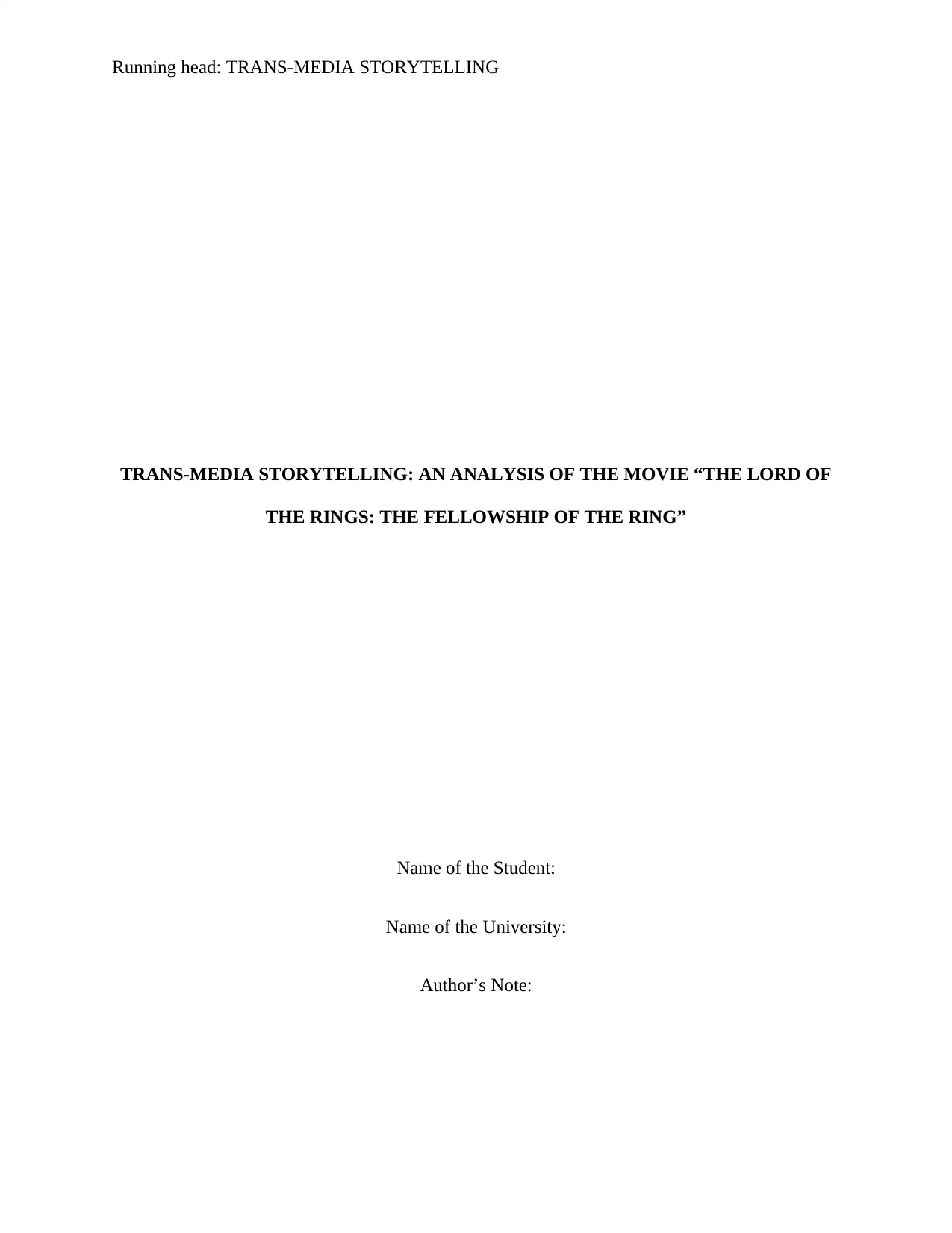
Running head: TRANS-MEDIA STORYTELLING
TRANS-MEDIA STORYTELLING: AN ANALYSIS OF THE MOVIE “THE LORD OF
THE RINGS: THE FELLOWSHIP OF THE RING”
Name of the Student:
Name of the University:
Author’s Note:
TRANS-MEDIA STORYTELLING: AN ANALYSIS OF THE MOVIE “THE LORD OF
THE RINGS: THE FELLOWSHIP OF THE RING”
Name of the Student:
Name of the University:
Author’s Note:
Paraphrase This Document
Need a fresh take? Get an instant paraphrase of this document with our AI Paraphraser
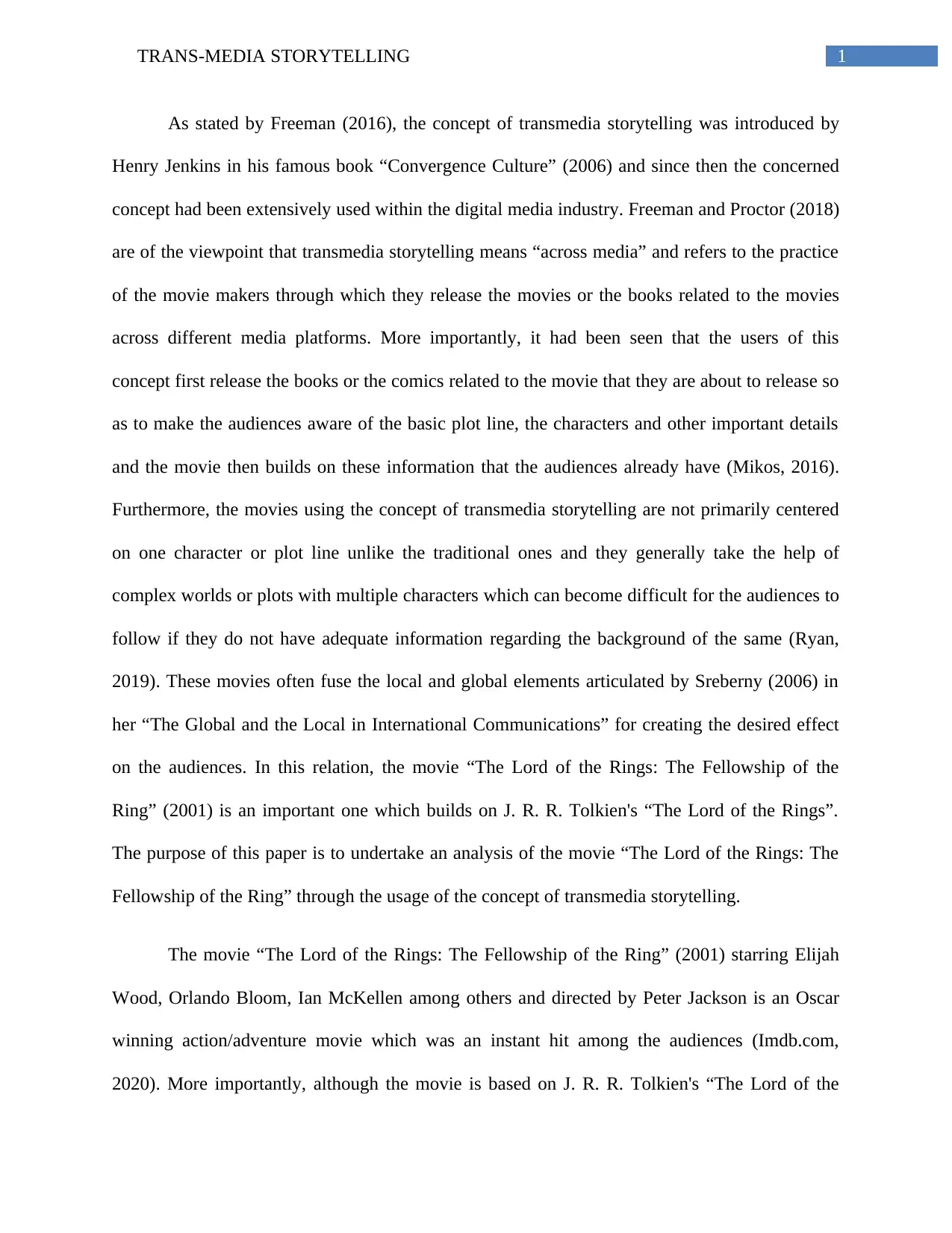
1TRANS-MEDIA STORYTELLING
As stated by Freeman (2016), the concept of transmedia storytelling was introduced by
Henry Jenkins in his famous book “Convergence Culture” (2006) and since then the concerned
concept had been extensively used within the digital media industry. Freeman and Proctor (2018)
are of the viewpoint that transmedia storytelling means “across media” and refers to the practice
of the movie makers through which they release the movies or the books related to the movies
across different media platforms. More importantly, it had been seen that the users of this
concept first release the books or the comics related to the movie that they are about to release so
as to make the audiences aware of the basic plot line, the characters and other important details
and the movie then builds on these information that the audiences already have (Mikos, 2016).
Furthermore, the movies using the concept of transmedia storytelling are not primarily centered
on one character or plot line unlike the traditional ones and they generally take the help of
complex worlds or plots with multiple characters which can become difficult for the audiences to
follow if they do not have adequate information regarding the background of the same (Ryan,
2019). These movies often fuse the local and global elements articulated by Sreberny (2006) in
her “The Global and the Local in International Communications” for creating the desired effect
on the audiences. In this relation, the movie “The Lord of the Rings: The Fellowship of the
Ring” (2001) is an important one which builds on J. R. R. Tolkien's “The Lord of the Rings”.
The purpose of this paper is to undertake an analysis of the movie “The Lord of the Rings: The
Fellowship of the Ring” through the usage of the concept of transmedia storytelling.
The movie “The Lord of the Rings: The Fellowship of the Ring” (2001) starring Elijah
Wood, Orlando Bloom, Ian McKellen among others and directed by Peter Jackson is an Oscar
winning action/adventure movie which was an instant hit among the audiences (Imdb.com,
2020). More importantly, although the movie is based on J. R. R. Tolkien's “The Lord of the
As stated by Freeman (2016), the concept of transmedia storytelling was introduced by
Henry Jenkins in his famous book “Convergence Culture” (2006) and since then the concerned
concept had been extensively used within the digital media industry. Freeman and Proctor (2018)
are of the viewpoint that transmedia storytelling means “across media” and refers to the practice
of the movie makers through which they release the movies or the books related to the movies
across different media platforms. More importantly, it had been seen that the users of this
concept first release the books or the comics related to the movie that they are about to release so
as to make the audiences aware of the basic plot line, the characters and other important details
and the movie then builds on these information that the audiences already have (Mikos, 2016).
Furthermore, the movies using the concept of transmedia storytelling are not primarily centered
on one character or plot line unlike the traditional ones and they generally take the help of
complex worlds or plots with multiple characters which can become difficult for the audiences to
follow if they do not have adequate information regarding the background of the same (Ryan,
2019). These movies often fuse the local and global elements articulated by Sreberny (2006) in
her “The Global and the Local in International Communications” for creating the desired effect
on the audiences. In this relation, the movie “The Lord of the Rings: The Fellowship of the
Ring” (2001) is an important one which builds on J. R. R. Tolkien's “The Lord of the Rings”.
The purpose of this paper is to undertake an analysis of the movie “The Lord of the Rings: The
Fellowship of the Ring” through the usage of the concept of transmedia storytelling.
The movie “The Lord of the Rings: The Fellowship of the Ring” (2001) starring Elijah
Wood, Orlando Bloom, Ian McKellen among others and directed by Peter Jackson is an Oscar
winning action/adventure movie which was an instant hit among the audiences (Imdb.com,
2020). More importantly, although the movie is based on J. R. R. Tolkien's “The Lord of the
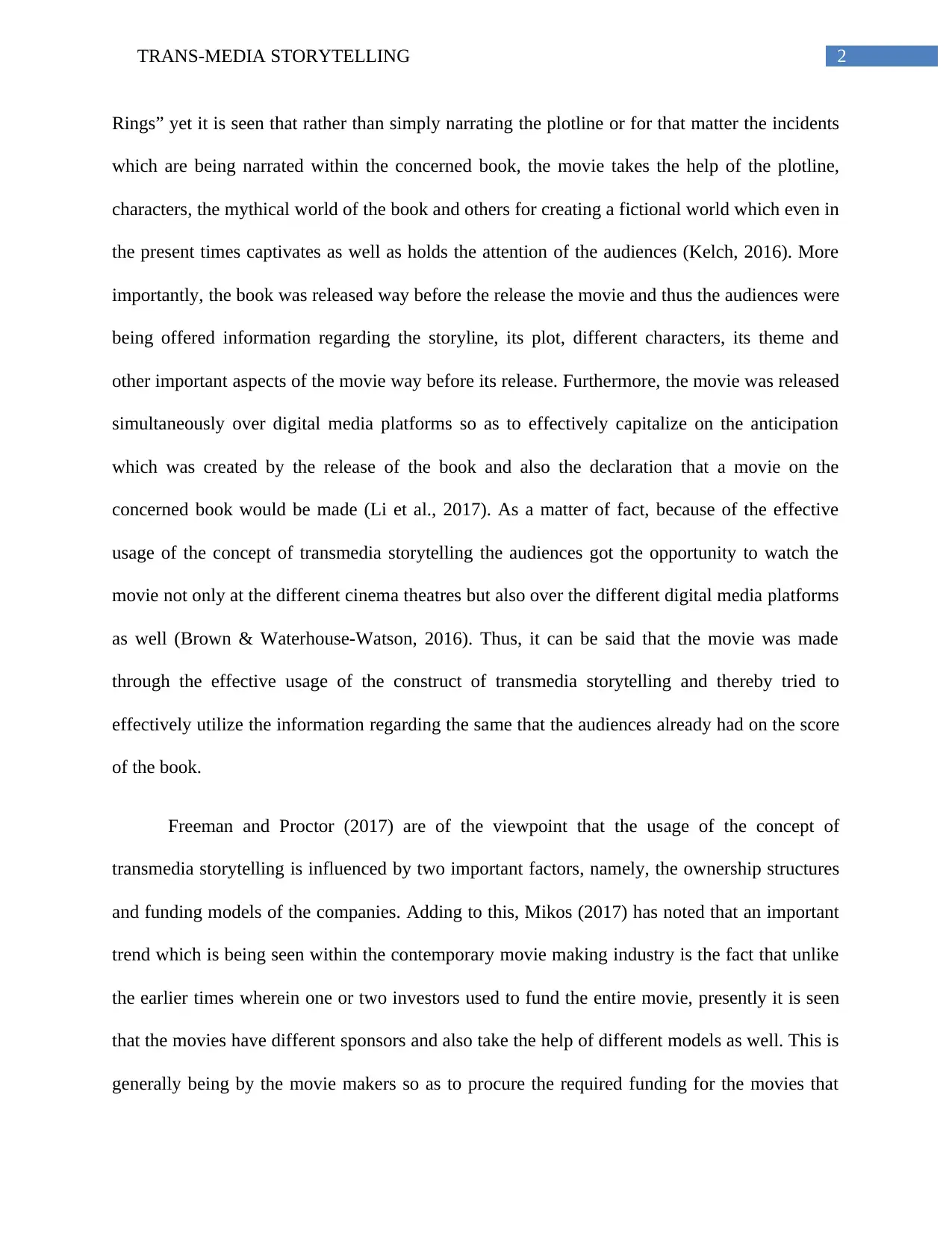
2TRANS-MEDIA STORYTELLING
Rings” yet it is seen that rather than simply narrating the plotline or for that matter the incidents
which are being narrated within the concerned book, the movie takes the help of the plotline,
characters, the mythical world of the book and others for creating a fictional world which even in
the present times captivates as well as holds the attention of the audiences (Kelch, 2016). More
importantly, the book was released way before the release the movie and thus the audiences were
being offered information regarding the storyline, its plot, different characters, its theme and
other important aspects of the movie way before its release. Furthermore, the movie was released
simultaneously over digital media platforms so as to effectively capitalize on the anticipation
which was created by the release of the book and also the declaration that a movie on the
concerned book would be made (Li et al., 2017). As a matter of fact, because of the effective
usage of the concept of transmedia storytelling the audiences got the opportunity to watch the
movie not only at the different cinema theatres but also over the different digital media platforms
as well (Brown & Waterhouse-Watson, 2016). Thus, it can be said that the movie was made
through the effective usage of the construct of transmedia storytelling and thereby tried to
effectively utilize the information regarding the same that the audiences already had on the score
of the book.
Freeman and Proctor (2017) are of the viewpoint that the usage of the concept of
transmedia storytelling is influenced by two important factors, namely, the ownership structures
and funding models of the companies. Adding to this, Mikos (2017) has noted that an important
trend which is being seen within the contemporary movie making industry is the fact that unlike
the earlier times wherein one or two investors used to fund the entire movie, presently it is seen
that the movies have different sponsors and also take the help of different models as well. This is
generally being by the movie makers so as to procure the required funding for the movies that
Rings” yet it is seen that rather than simply narrating the plotline or for that matter the incidents
which are being narrated within the concerned book, the movie takes the help of the plotline,
characters, the mythical world of the book and others for creating a fictional world which even in
the present times captivates as well as holds the attention of the audiences (Kelch, 2016). More
importantly, the book was released way before the release the movie and thus the audiences were
being offered information regarding the storyline, its plot, different characters, its theme and
other important aspects of the movie way before its release. Furthermore, the movie was released
simultaneously over digital media platforms so as to effectively capitalize on the anticipation
which was created by the release of the book and also the declaration that a movie on the
concerned book would be made (Li et al., 2017). As a matter of fact, because of the effective
usage of the concept of transmedia storytelling the audiences got the opportunity to watch the
movie not only at the different cinema theatres but also over the different digital media platforms
as well (Brown & Waterhouse-Watson, 2016). Thus, it can be said that the movie was made
through the effective usage of the construct of transmedia storytelling and thereby tried to
effectively utilize the information regarding the same that the audiences already had on the score
of the book.
Freeman and Proctor (2017) are of the viewpoint that the usage of the concept of
transmedia storytelling is influenced by two important factors, namely, the ownership structures
and funding models of the companies. Adding to this, Mikos (2017) has noted that an important
trend which is being seen within the contemporary movie making industry is the fact that unlike
the earlier times wherein one or two investors used to fund the entire movie, presently it is seen
that the movies have different sponsors and also take the help of different models as well. This is
generally being by the movie makers so as to procure the required funding for the movies that
⊘ This is a preview!⊘
Do you want full access?
Subscribe today to unlock all pages.

Trusted by 1+ million students worldwide
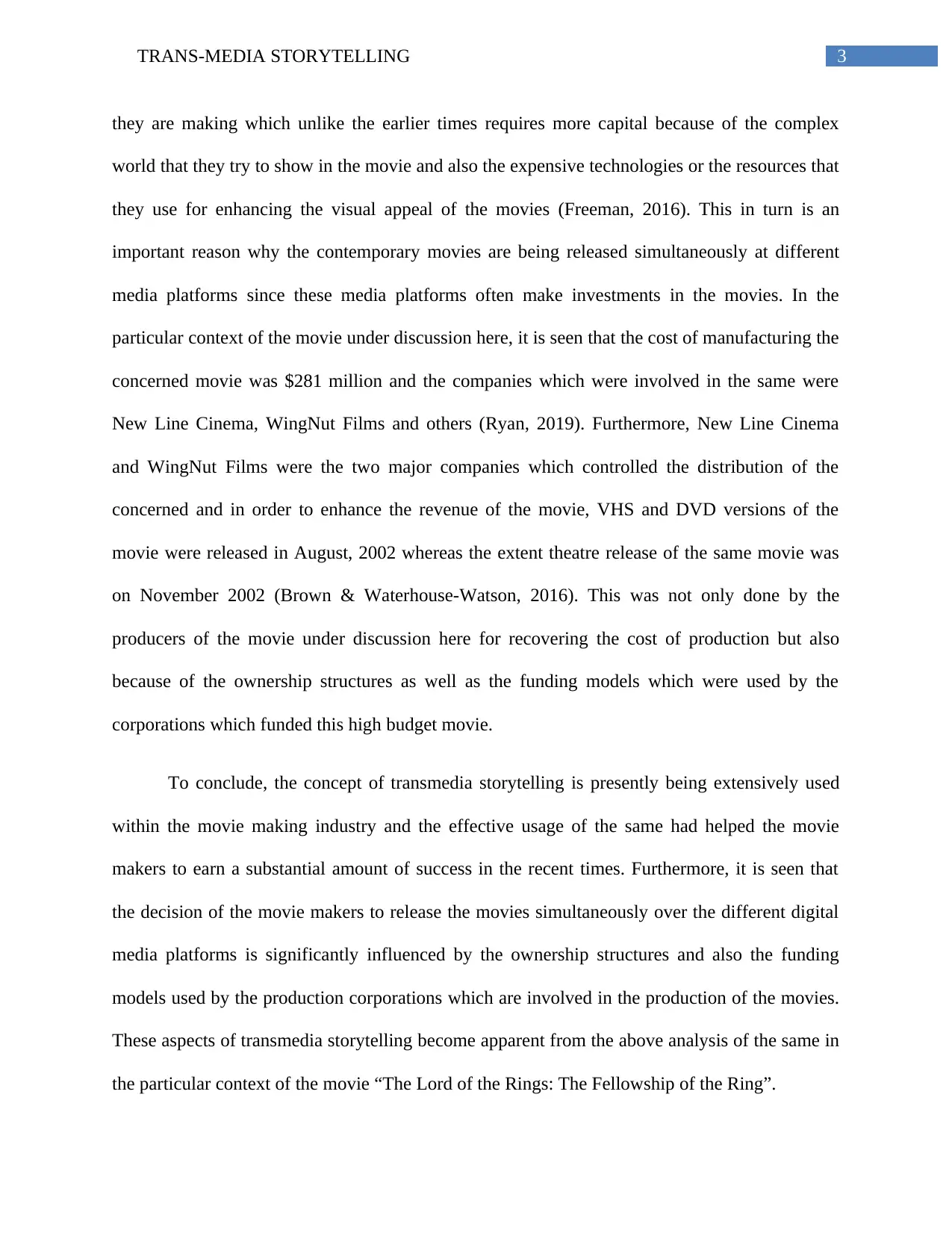
3TRANS-MEDIA STORYTELLING
they are making which unlike the earlier times requires more capital because of the complex
world that they try to show in the movie and also the expensive technologies or the resources that
they use for enhancing the visual appeal of the movies (Freeman, 2016). This in turn is an
important reason why the contemporary movies are being released simultaneously at different
media platforms since these media platforms often make investments in the movies. In the
particular context of the movie under discussion here, it is seen that the cost of manufacturing the
concerned movie was $281 million and the companies which were involved in the same were
New Line Cinema, WingNut Films and others (Ryan, 2019). Furthermore, New Line Cinema
and WingNut Films were the two major companies which controlled the distribution of the
concerned and in order to enhance the revenue of the movie, VHS and DVD versions of the
movie were released in August, 2002 whereas the extent theatre release of the same movie was
on November 2002 (Brown & Waterhouse-Watson, 2016). This was not only done by the
producers of the movie under discussion here for recovering the cost of production but also
because of the ownership structures as well as the funding models which were used by the
corporations which funded this high budget movie.
To conclude, the concept of transmedia storytelling is presently being extensively used
within the movie making industry and the effective usage of the same had helped the movie
makers to earn a substantial amount of success in the recent times. Furthermore, it is seen that
the decision of the movie makers to release the movies simultaneously over the different digital
media platforms is significantly influenced by the ownership structures and also the funding
models used by the production corporations which are involved in the production of the movies.
These aspects of transmedia storytelling become apparent from the above analysis of the same in
the particular context of the movie “The Lord of the Rings: The Fellowship of the Ring”.
they are making which unlike the earlier times requires more capital because of the complex
world that they try to show in the movie and also the expensive technologies or the resources that
they use for enhancing the visual appeal of the movies (Freeman, 2016). This in turn is an
important reason why the contemporary movies are being released simultaneously at different
media platforms since these media platforms often make investments in the movies. In the
particular context of the movie under discussion here, it is seen that the cost of manufacturing the
concerned movie was $281 million and the companies which were involved in the same were
New Line Cinema, WingNut Films and others (Ryan, 2019). Furthermore, New Line Cinema
and WingNut Films were the two major companies which controlled the distribution of the
concerned and in order to enhance the revenue of the movie, VHS and DVD versions of the
movie were released in August, 2002 whereas the extent theatre release of the same movie was
on November 2002 (Brown & Waterhouse-Watson, 2016). This was not only done by the
producers of the movie under discussion here for recovering the cost of production but also
because of the ownership structures as well as the funding models which were used by the
corporations which funded this high budget movie.
To conclude, the concept of transmedia storytelling is presently being extensively used
within the movie making industry and the effective usage of the same had helped the movie
makers to earn a substantial amount of success in the recent times. Furthermore, it is seen that
the decision of the movie makers to release the movies simultaneously over the different digital
media platforms is significantly influenced by the ownership structures and also the funding
models used by the production corporations which are involved in the production of the movies.
These aspects of transmedia storytelling become apparent from the above analysis of the same in
the particular context of the movie “The Lord of the Rings: The Fellowship of the Ring”.
Paraphrase This Document
Need a fresh take? Get an instant paraphrase of this document with our AI Paraphraser
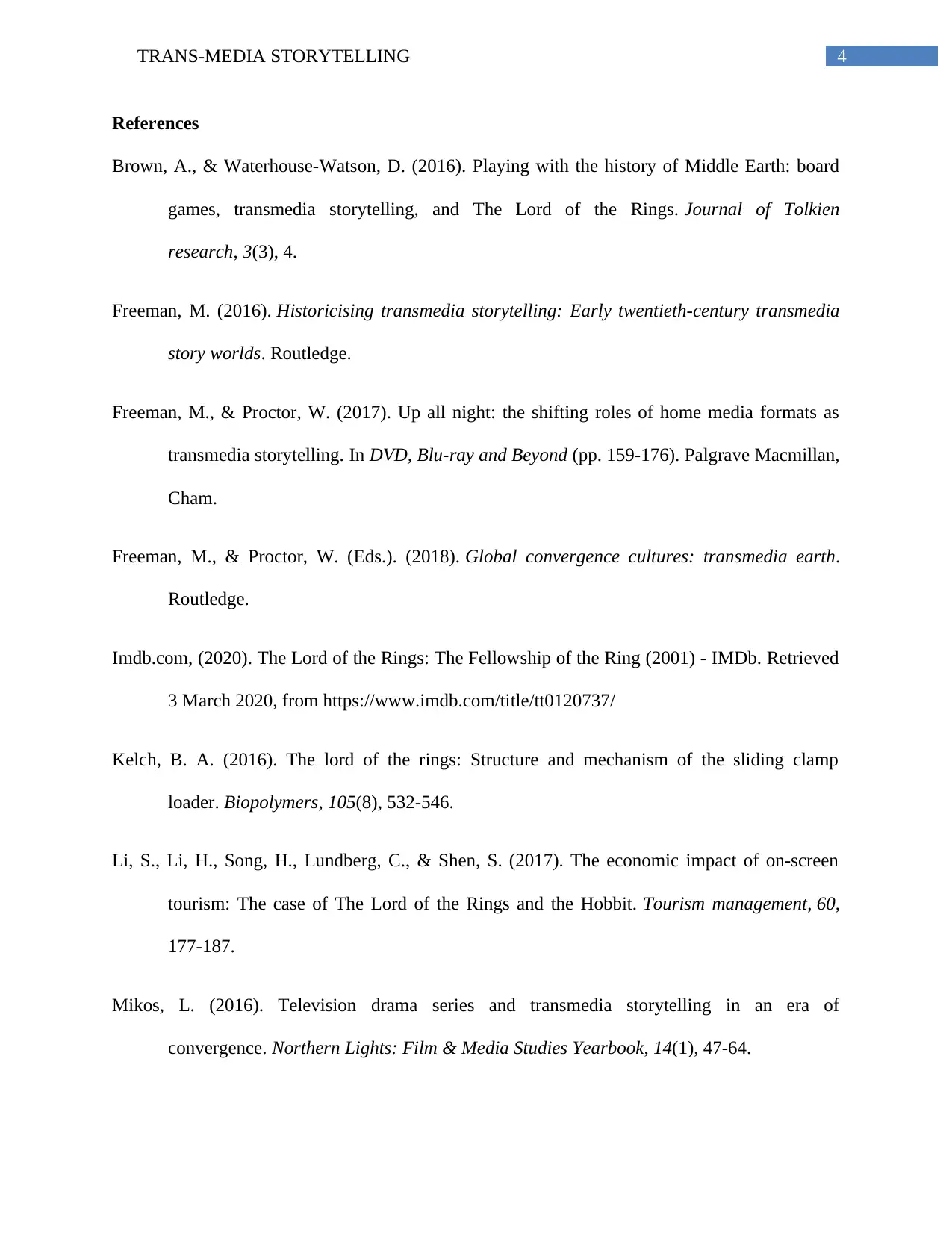
4TRANS-MEDIA STORYTELLING
References
Brown, A., & Waterhouse-Watson, D. (2016). Playing with the history of Middle Earth: board
games, transmedia storytelling, and The Lord of the Rings. Journal of Tolkien
research, 3(3), 4.
Freeman, M. (2016). Historicising transmedia storytelling: Early twentieth-century transmedia
story worlds. Routledge.
Freeman, M., & Proctor, W. (2017). Up all night: the shifting roles of home media formats as
transmedia storytelling. In DVD, Blu-ray and Beyond (pp. 159-176). Palgrave Macmillan,
Cham.
Freeman, M., & Proctor, W. (Eds.). (2018). Global convergence cultures: transmedia earth.
Routledge.
Imdb.com, (2020). The Lord of the Rings: The Fellowship of the Ring (2001) - IMDb. Retrieved
3 March 2020, from https://www.imdb.com/title/tt0120737/
Kelch, B. A. (2016). The lord of the rings: Structure and mechanism of the sliding clamp
loader. Biopolymers, 105(8), 532-546.
Li, S., Li, H., Song, H., Lundberg, C., & Shen, S. (2017). The economic impact of on-screen
tourism: The case of The Lord of the Rings and the Hobbit. Tourism management, 60,
177-187.
Mikos, L. (2016). Television drama series and transmedia storytelling in an era of
convergence. Northern Lights: Film & Media Studies Yearbook, 14(1), 47-64.
References
Brown, A., & Waterhouse-Watson, D. (2016). Playing with the history of Middle Earth: board
games, transmedia storytelling, and The Lord of the Rings. Journal of Tolkien
research, 3(3), 4.
Freeman, M. (2016). Historicising transmedia storytelling: Early twentieth-century transmedia
story worlds. Routledge.
Freeman, M., & Proctor, W. (2017). Up all night: the shifting roles of home media formats as
transmedia storytelling. In DVD, Blu-ray and Beyond (pp. 159-176). Palgrave Macmillan,
Cham.
Freeman, M., & Proctor, W. (Eds.). (2018). Global convergence cultures: transmedia earth.
Routledge.
Imdb.com, (2020). The Lord of the Rings: The Fellowship of the Ring (2001) - IMDb. Retrieved
3 March 2020, from https://www.imdb.com/title/tt0120737/
Kelch, B. A. (2016). The lord of the rings: Structure and mechanism of the sliding clamp
loader. Biopolymers, 105(8), 532-546.
Li, S., Li, H., Song, H., Lundberg, C., & Shen, S. (2017). The economic impact of on-screen
tourism: The case of The Lord of the Rings and the Hobbit. Tourism management, 60,
177-187.
Mikos, L. (2016). Television drama series and transmedia storytelling in an era of
convergence. Northern Lights: Film & Media Studies Yearbook, 14(1), 47-64.
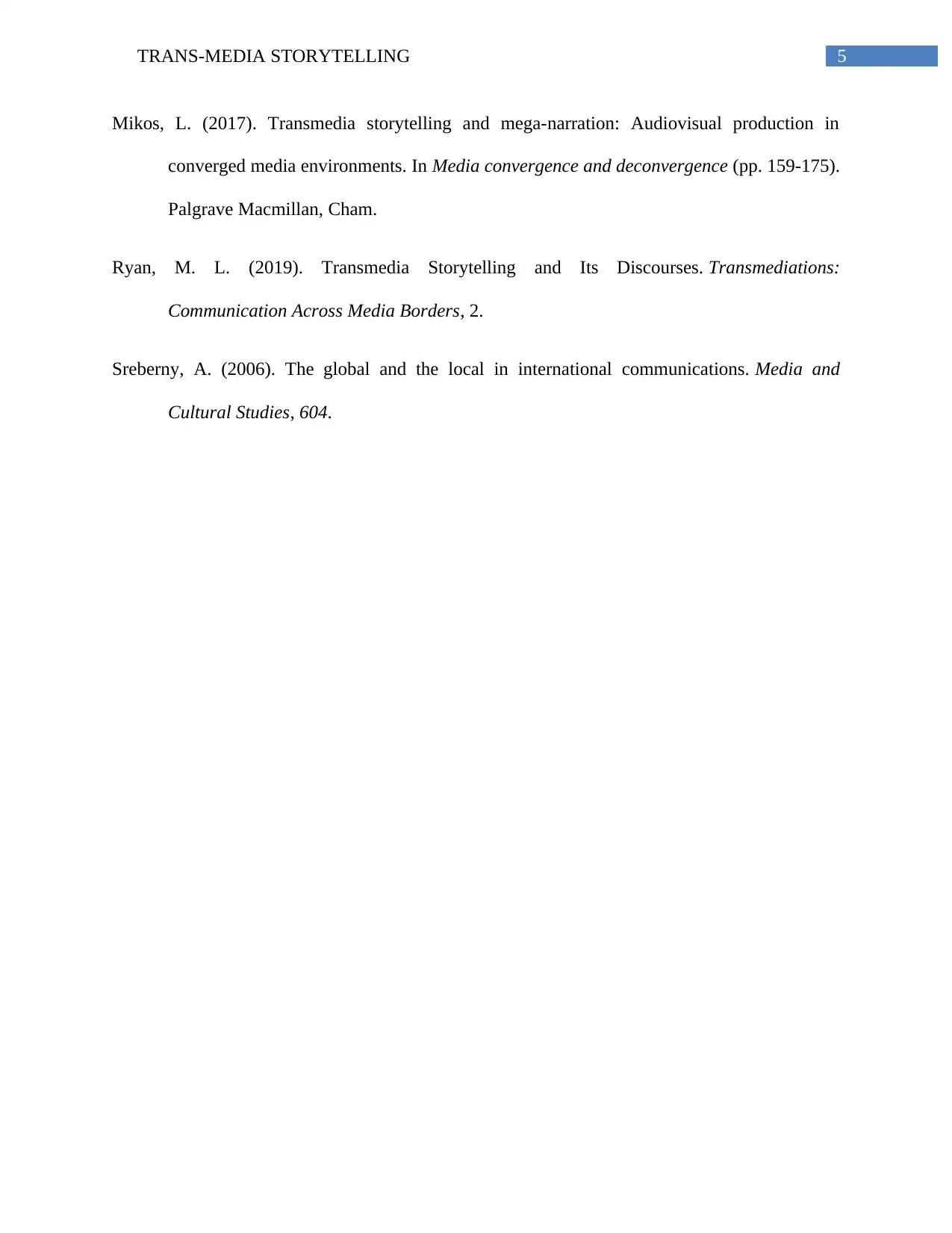
5TRANS-MEDIA STORYTELLING
Mikos, L. (2017). Transmedia storytelling and mega-narration: Audiovisual production in
converged media environments. In Media convergence and deconvergence (pp. 159-175).
Palgrave Macmillan, Cham.
Ryan, M. L. (2019). Transmedia Storytelling and Its Discourses. Transmediations:
Communication Across Media Borders, 2.
Sreberny, A. (2006). The global and the local in international communications. Media and
Cultural Studies, 604.
Mikos, L. (2017). Transmedia storytelling and mega-narration: Audiovisual production in
converged media environments. In Media convergence and deconvergence (pp. 159-175).
Palgrave Macmillan, Cham.
Ryan, M. L. (2019). Transmedia Storytelling and Its Discourses. Transmediations:
Communication Across Media Borders, 2.
Sreberny, A. (2006). The global and the local in international communications. Media and
Cultural Studies, 604.
⊘ This is a preview!⊘
Do you want full access?
Subscribe today to unlock all pages.

Trusted by 1+ million students worldwide
1 out of 6
Your All-in-One AI-Powered Toolkit for Academic Success.
+13062052269
info@desklib.com
Available 24*7 on WhatsApp / Email
![[object Object]](/_next/static/media/star-bottom.7253800d.svg)
Unlock your academic potential
Copyright © 2020–2025 A2Z Services. All Rights Reserved. Developed and managed by ZUCOL.

